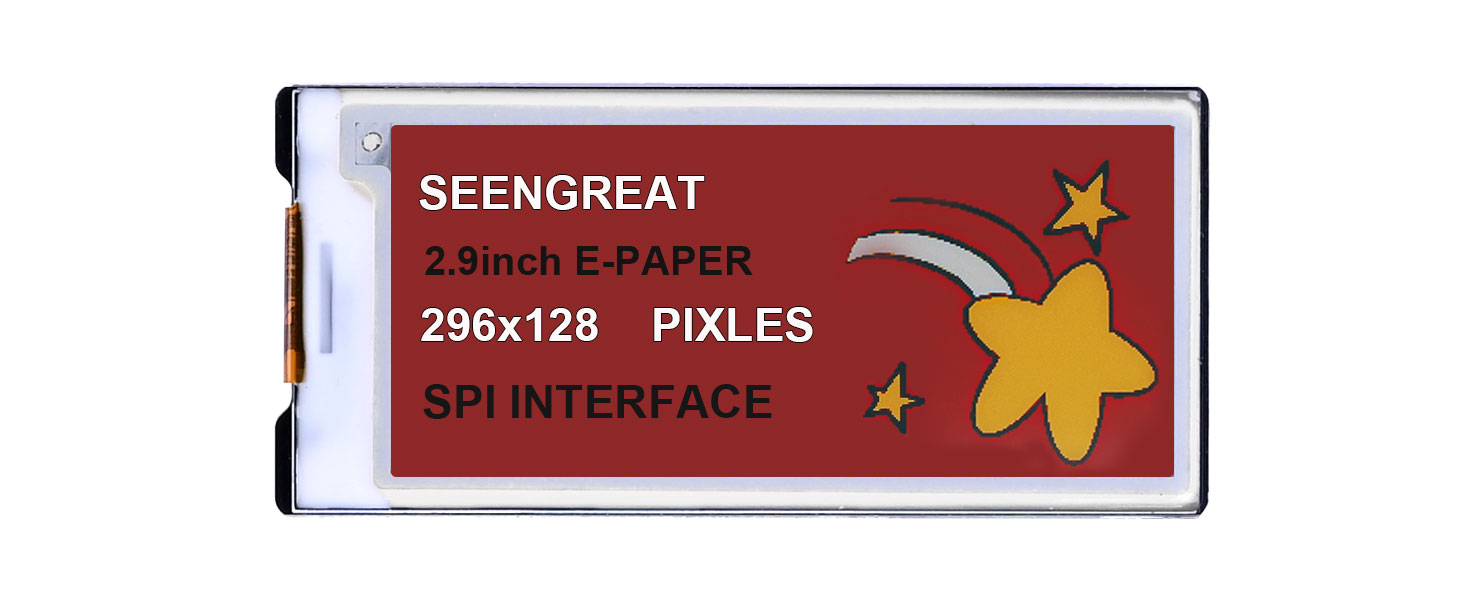 Ⅰ Product Introduction
Ⅰ Product Introduction
This product is a 2.9-inch 4-color ink screen, supporting black, white, yellow and red 4 color display.Its resolution is 296x128, using SPI communication mode, and supporting full refresh mode.We provide example programs in C and Python for Raspberry Pi. A reserved SPI control interface allows easy integration with main control boards such as Arduino, STM32, and ESP32. We also offer example code for Arduino, STM32, and ESP32, which supports displaying images, English and numerical characters, and drawing points, lines, rectangles, and circles.
1.1 Product Features
- Resolution:296x128
- SPI interface, requiring fewer pins
- Onboard level-shifting chip, compatible with 3.3V and 5V microcontroller interfaces
- Reserved SPI communication interface for easy integration with main control boards such as Arduino, STM32, and ESP32
- Provides open-source example programs for Raspberry Pi, Arduino, STM32, and ESP32 development boards
1.2 Product Specifications
Pixels | 296x128 |
Display Colors | 4 colors: black, white, yellow, red |
Level-Shifting Chip | TXS0108EPWR |
Signal Interface | SPI |
Power Supply Voltage | 3.3V/5V |
Full Refresh | 20s |
Display Direction | Horizontal and vertical |
Operating Temperature | 0℃-40℃ |
FPC Interface | 0.5mm pitch 24 Pin |
RefreshPowerConsumption | 9.9mW |
Standby Power Consumption | 0.003mW |
Explanation of the refresh process (refresh time: the entire process from the beginning of the screen action to the stabilization of the screen):
Full Refresh: During the refresh process, the screen will flash many times.
1.3 Interface Definition
VCC | 3.3V/5V |
GND | Power ground |
RST | External reset pin (low level reset) |
BUSY | Busy status output pin |
D/C | Data/Command control pin (high level for data, low level for command) |
MOSI | SPI communication MOSI pin |
CS | SPI chip select pin (active low) |
CLK | SPI communication SCK pin |
1.4 Product Dimensions
Dimensions | 82mm x 38.1mm |
Display area | 66.90mm x 29.06mm |
1.5 Product Advantages
E-paper uses "microcapsule electrophoretic display" technology for image display. Its working principle involves charged nanoparticles suspended in a liquid that migrate under the influence of an electric field, creating a display effect close to traditional printed paper through reflection under ambient light. Once refreshed, it requires no power and can maintain the displayed image for a long time. E-paper can clearly display images under various lighting conditions, including ambient and natural light, without the need for backlighting, and offers an almost 180° viewing angle. Due to its paper-like display quality, it is commonly used in e-readers, labels, and similar applications.
1.6 Application
Suitable for e-book readers, electronic price tags, industrial and logistics labels, digital signage, billboards, conference nameplates, electronic memos, etc.
II Resource Overview
The overview of the driver resources is shown in the figure below:

Figure 1-5 Driver Board Resource Overview
① 2.9-inch black-white-yellow-red 4-color ink screen
② E-paper screen connector
③ SPI control interface connector
④ Level-shifting chip TXS0108EPWR
⑤ SPI lines count selection switch(default is "0" position)
Ⅲ Usage
All the demo codes provided by this product are based on the 4-wire SPI mode, so the BS selection switch on the back of the board is set to "0" by default.
3.1Raspberry Pi Example Usage
The example code for the Raspberry Pi platform is divided into two versions: lgpio and wiringpi. The bookworm system uses the lgpio library, while the bullseye system uses the wiringpi library.
3.1.1Raspberry Pi Platform Interface Definition
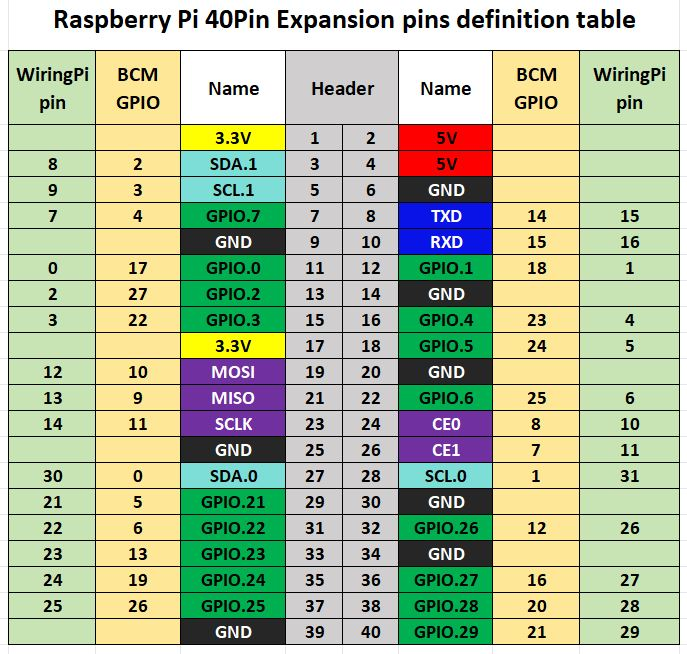
Figure 3-1 Raspberry Pi interface diagram
The following figure shows the wiring diagram between the Raspberry Pi and the ink screen: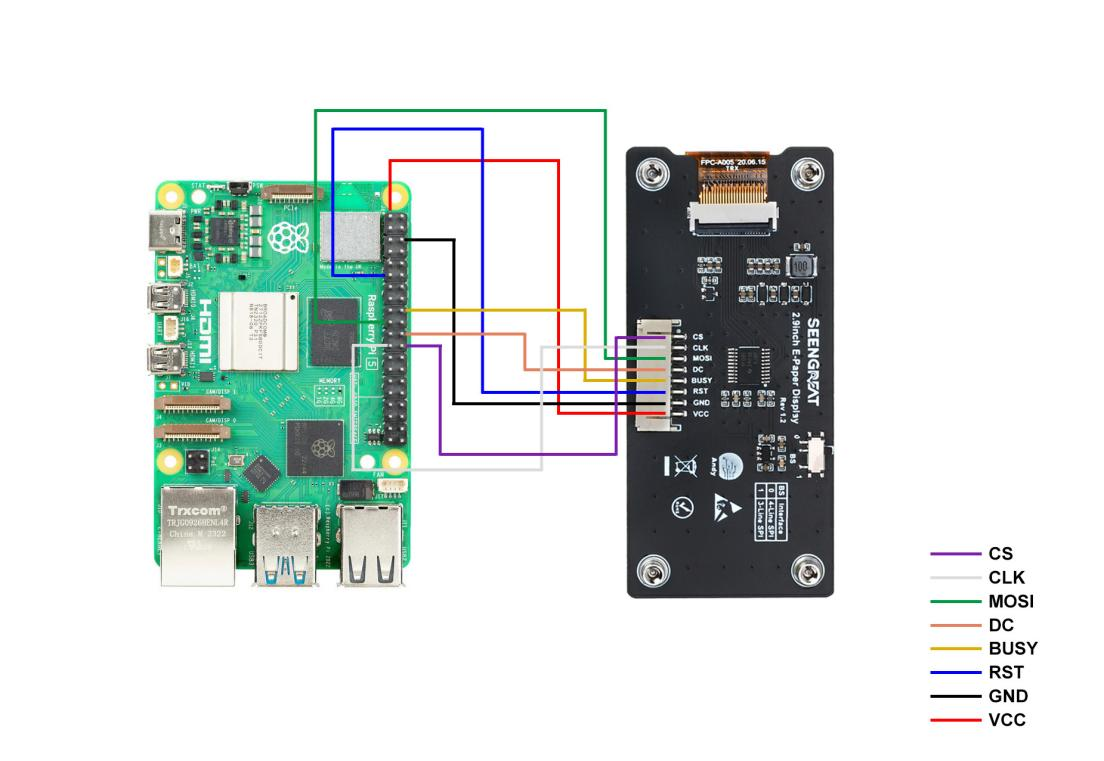
The example programs for the Raspberry Pi board use the BCM numbering for pin definitions with the lgpio library and the wiringpi numbering with the wiringpi library. The pin wiring definitions for the Raspberry Pi board are as shown in the table below:
E-paper Interface (E-paper Connector) | Pin Function | BCM Numbering | Wiringpi Numbering |
VCC | 3.3V | ||
GND | GND | ||
BUSY | Busy Signal Pin | 24 | 5 |
RSTN | Reset | 17 | 0 |
D/C | Command/Data Select | 25 | 6 |
SDA | SPI Data Out/Slave In | 10 | 12 |
SCL | SPI Clock | 11 | 14 |
CSB | SPI Chip Select | 8 | 10 |
LED1 | 4 | 7 | |
LED2 | 18 | 1 | |
K1 | 27 | 2 | |
K2 | 22 | 3 |
Table 3-1 Driver Board and Raspberry Pi Pin Definitions
3.1.2 wiringpi Library Installation
sudo apt-get install wiringpi
wget https://project-downloads.drogon.net/wiringpi-latest.debUpgrade Raspberry Pi 4B Version:
sudo dpkg -i wiringpi-latest.deb
gpio -vIf version 2.52 appears, it indicates that the installation has been successful.
- For the Bullseye branch system, use the following command:
git clone https://github.com/WiringPi/WiringPi cd WiringPi . /build gpio -v
Running "gpio -v" will show version 2.70. If it doesn't appear, it means there is an installation error.
If an error message "ImportError: No module named 'wiringpi'" appears when running a sample program in Python version, run the following command:
- For Python 2.x version
pip install wiringpi
- For Python 3.x version
pip3 install wiringpi
Note: If the installation fails, you can try the following compiled installation.
git clone --recursive
https://github.com/WiringPi/WiringPi-Python.gitNote: The --recursive option can automatically pull submodules. Otherwise, you need to download them manually.
Enter the newly downloaded WiringPi-Python folder and use the following commands to compile and install:
- For Python 2.x version
sudo python setup.py install - For Python 3.x version
sudo python3 setup.py installIf the following error occurs:
In this case, enter the command sudo apt install swig to install SWIG. After completing the installation, run sudo python3 setup.py install to compile and install. If you see similar information, it indicates that the installation was successful.

3.1.3 lgpio Library Installation
For the Bookworm system, the example programs use the lgpio library. The installation command for this library is:
wget https://github.com/joan2937/lg/archive/master.zip
unzip master.zip
cd lg-master
Make
sudo make install3.1.4 Enable the SPI Interface
sudo raspi-configEnable the SPI Interface:
Interfacing Options->SPI->YesCheck the enabled SPI devices:
ls /dev/spi*This will print: "/dev/spidev0.0" and "/dev/spidev0.1"
3.1.5 Python Library Installation
The example program uses the Python 3 environment. To run the Python example program, you need to install the PIL, numpy, and spidev libraries. Enter the following commands to install them:
sudo apt-get install python3-pil
sudo apt-get install python3-numpy
sudo apt-get install python3-pip
sudo pip3 install spidev3.1.6 C Version Example
Using the lgpio library as an example, navigate to the /demo codes/raspberry_pi/lgpio/c directory:
sudo make clean
sudo make
sudo ./mainAfter entering the above commands, you can observe the e-paper display.
3.1.7 Python Version Example
Using the lgpio library as an example, navigate to the /demo codes/raspberry_pi/lgpio/python directory.
sudo python3 gui_demo.pyAfter entering the above commands, you can observe the e-paper display.
3.2 Arduino Example Usage
3.2.1 Hardware Interface Configuration
Table 3-2 shows the wiring definitions between the Arduino Mega and the e-paper display:
E-paper Interface | Arduino Mega |
VCC | 5V |
GND | GND |
CS | D53 |
CLK | D52 |
MOSI | D51 |
DC | D8 |
RST | D9 |
BUSY | D10 |
Table 3-2 E-paper Display and Arduino Mega Pin Definitions
The following diagram shows the wiring diagram between the Arduino Mega and the ink screen: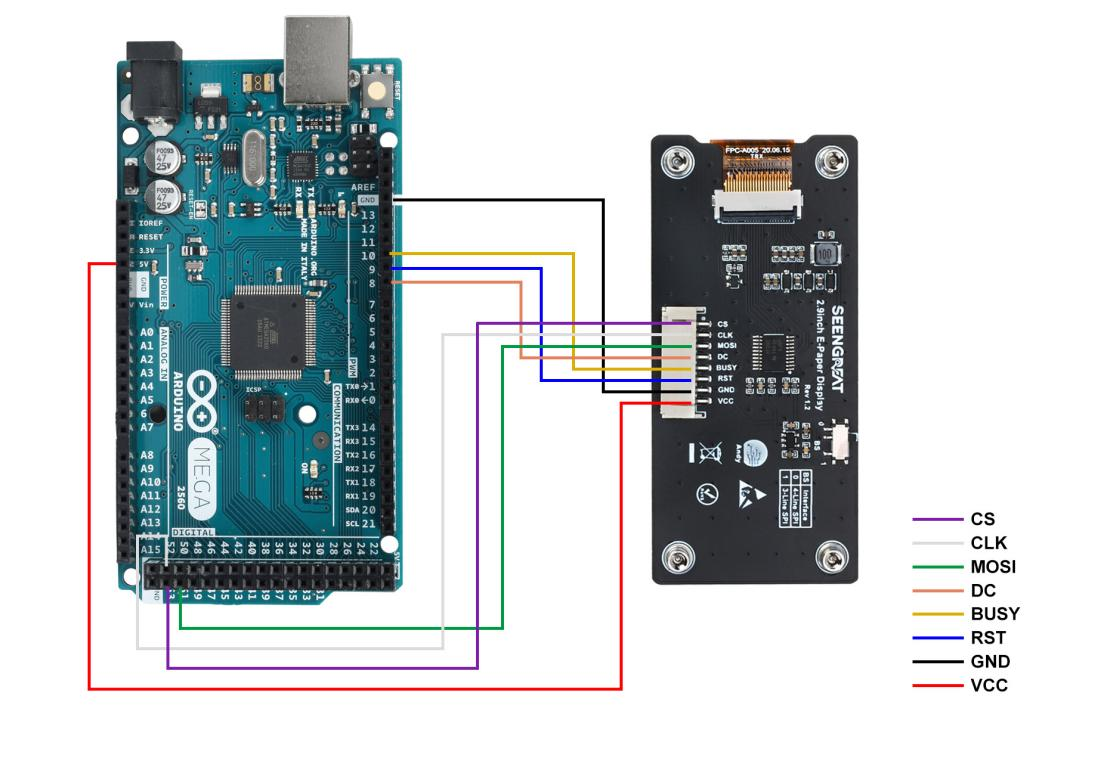
Table 3-3 E-paper Display and Arduino UNO Pin Definitions:
E-paper Interface | Arduino UNO |
VCC | 5V |
GND | GND |
CS | D7 |
CLK | D13 |
MOSI | D11 |
DC | D10 |
RST | D9 |
BUSY | D8 |
Table 3-3 E-paper Display and Arduino UNO Pin Definitions
The following diagram shows the wiring diagram between the Arduino UNO and the ink screen: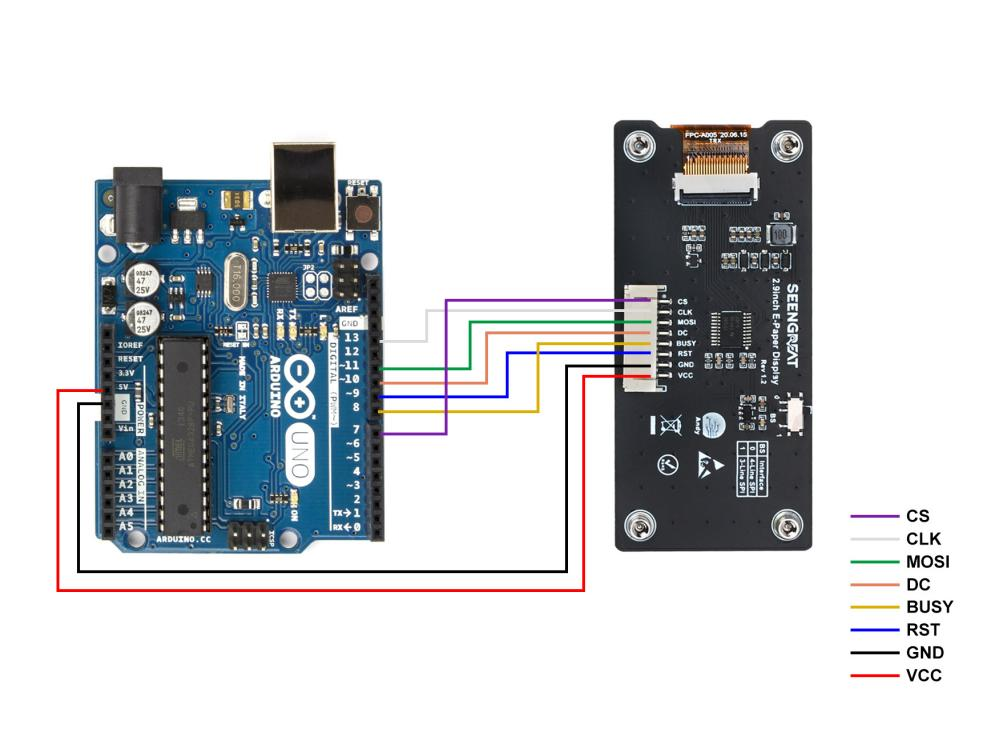
3.2.2 Example Usage
Open the project file /demo codes/Arduino_MEGA/Arduino_MEGA.ino or /demo codes/Arduino_UNO/Arduino_UNO.ino in the Arduino IDE. Select the correct Board and Port based on your setup. Click Verify, and once the verification is successful, upload it to the module. Observe the e-paper display.
Note: Due to the small memory resources of Arduino, when using Arduino related routines, it is not possible to refresh and display multiple pictures at the same time, please refresh as few pictures as possible, and use as few font types as possible at the same time when using the GUI display in the routine, otherwise there will be a prompt that the memory is exceeded.
3.3 STM32 Example Usage
The example code is based on STM32F103RBT6.
3.3.1 Hardware Interface Configuration
E-paper Interface | STM32 Interface |
VCC | 3.3V |
GND | GND |
CS | PB12 |
CLK | PB13 |
MOSI | PB15 |
DC | PA8 |
RST | PA11 |
BUSY | PA12 |
Table 3-4 E-paper Display and STM32 Pin Definitions
The following diagram shows the wiring diagram between STM32 and the ink screen:
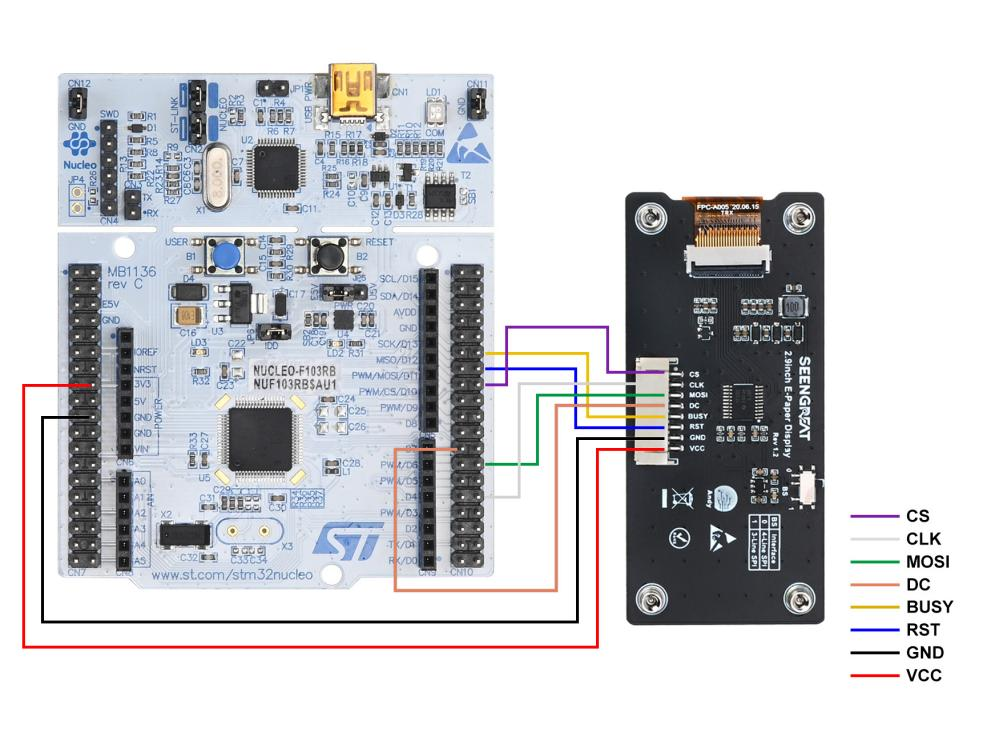
3.3.2 Example Usage
Open the example in the directory /demo codes/STM32 using Keil uVision5 software. After compiling without errors, download it to the module and observe the e-paper display.
3.4ESP32 Example Usage
The example program uses the ESP32 module ESP32-WROOM-32E.(Model of the board in the IDE:NodeMCU-32S)
E-paper Interface | ESP32 Interface |
VCC | 3.3V |
GND | GND |
CS | IO27 |
CLK | IO18 |
MOSI | IO23 |
DC | IO14 |
RST | IO33 |
BUSY | IO13 |
Table 3-5 E-paper Display and ESP32 Pin Definitions
The following figure shows the wiring diagram between ESP32 and the ink screen: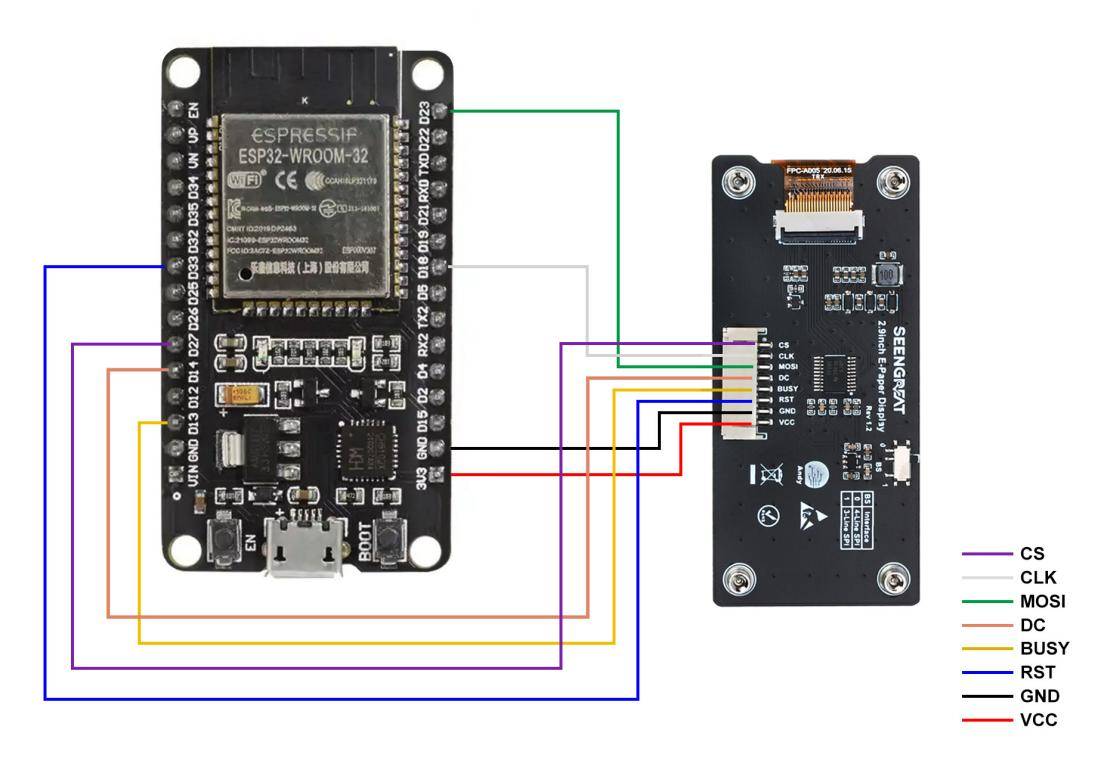
3.4.1 Example Usage
Open the project file /demo codes/Arduino_ESP32 using the Arduino IDE. Select the correct Board and Port based on your setup. Click Verify, and once the verification is successful, upload it to the module and observe the e-paper display.
3.5 Image Creation and Mode Extraction
Please refer to the link:https://seengreat.com/wiki/193
